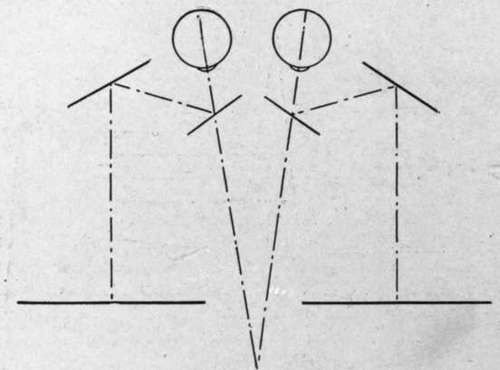Stereoscopes
Description
This section is from the book "Airplane Photography", by Herbert E. Ives. Also available from Amazon: Airplane photography.
Stereoscopes
The easier and more usual method of fusing the stereoscopic images is by a stereoscope. The simplest form consists merely of two convex lenses, one for each eye, their centers separated by a distance somewhat greater than that between the eyes. Their function is to bring the stereogram to focus, and, by the prismatic action of the edges of the lenses, to converge the lines of sight viewing stereo X-ray pictures. It consists of two vertical mirrors at right angles to each other, with their edge of contact between the eyes. The two prints to be studied are placed to right and left, an arrangement that permits the use of prints of any size. The convergence point is controlled by the angle between the mirrors. The Pellin stereoscope without an instrument. No adjustment is provided for varying the lens separation, but the print can be moved to and fro for focussing.

Fig. 151. - Box stereoscope.
Another form of stereoscope, one of the first produced, is the mirror stereoscope (Fig. 152), now used extensively for (Fig. 153) utilizes two pairs of mirrors in a way to permit the use of large prints. The prints are, however, placed side by side on a horizontal viewing table, which avoids certain difficulties of illumination met with in the simpler mirror form. The box form of stereoscope (Fig. 151) using either prisms or simple convex lenses, is particularly adapted for viewing transparencies, although the insertion of a door at the top provides illumination for paper prints. The Schweissguth design (Fig. 154) is intended primarily as an aid to selecting the portions of the prints to be cut out for mounting. The platform on which the pictures rest is composed of two long rectangular blocks, on which are plates of glass raised sufficiently to permit the prints to be slid underneath. The space between the blocks allows the unused portion of the photograph to be turned down out of the way. Prints of any size can thus be moved about until the proper portions for stereo mounting are found. Either block can be moved in its own plane and also to and from the eye, whereby two prints of somewhat different scales can be fused.

Fig. 152. - Diagram of mirror stereoscope.

Fig. 153. - Pellin double mirror stereoscope.

Fig. 154. - Schweissguth stereoscope, used for selecting portions of prints to be mounted.
Continue to:
Tags
camera, lens, airplane, aerial, film, exposure, photography, maps, birdseye
